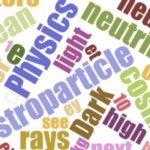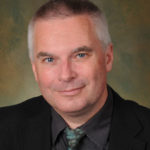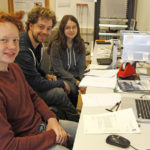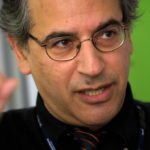
Researchers detect possible signal from dark matter
11 December 2014
Phys.org News – Researchers detect possible signal from dark matter

11 December 2014
Phys.org News – Researchers detect possible signal from dark matter

10 December 2014

9 December 2014
CoPoRI1 in close cooperation with ESFRI2 and the European Commission organized on 25th September 2014 in Trieste, Italy a remarkable workshop, in an attempt to raise awareness among the scientific community about the next Roadmap update in 2015-2016. A detailed analysis of the Research Infrastructures landscape within specific scientific fields was presented, highlighting the role of ESFRI. The next Roadmap update was outlined, as well as its interfaces with Horizon 2020 and other relevant national and European interfaces. “The launch workshop was held to raise awareness of ESFRI’s roadmap update which is now starting, with a deadline of March 31, 2015 for new projects to be proposed. The workshop aimed to explain the process of submission and evaluation and provide an opportunity for funders and project proponents to ask questions,” says John Womersley, Chief Executive Officer of the Science and Technology Facilities Council (STFC).
The term ‘research infrastructures’ (RIs) refers to facilities, resources and related services used by the scientific community to conduct top-level research in their respective fields. They range from local/national to European/international scales, they may be single-sited, distributed, or virtual. RIs are at the center of the knowledge triangle of research, education and innovation: they attract young people to science, bridge scientific communities across countries, attract the best researchers from around the world providing shared access to unique or distributed scientific facilities, drive scientific discoveries and technological developments and thus bring together a wide diversity of stakeholders looking for solutions to current problems that society is facing. Since its inception in 2002 “ESFRI has delivered a coordinated, strategy-led approach to planning for big research facilities across Europe. It has avoided duplication and has raised the profile of these projects, highlighting the need for investment”.
The ESFRI Roadmap identifies new pan-European Research Infrastructures or major upgrades to existing ones, to meet the needs of European research communities in the next 10 to 20 years, in all fields of research. The first roadmap was released in 2006 and included 35 new RIs (or major upgrades of existing ones). It was followed by an update in 2008 and a further update focusing on Energy, Food and Biology, published in 2010. “ESFRI has helped to explain the socio-economic impacts of large research infrastructures but I think there is still more work to be done in this area”.
ESFRI’s mandate has been expanded by the Council in December 2012 to ensure the follow-up of implementation of already on-going ESFRI projects, as well as the prioritization of the infrastructure projects listed in the ESFRI roadmap. A further update came at the Informal Competitiveness Council in Milano (July 2014) to complete a new Roadmap for 2016 with new criteria of selection and format. “The new roadmap will contain a much shorter and more focused list of projects – around 25 compared with 48 in the present roadmap. It will also contain much more discussion of the overall research landscape and the interaction with existing projects and will also describe the ‘success stories’ in terms of projects from the earlier roadmaps that are now under construction or delivering science”. It will be more of a strategy document to achieve optimal use, continuous upgrade sustainability and end of life perspectives.
European astronomy and astroparticle physics remains very competitive on an international scale, the research areas in the two communities merging together, from solar research to gravity waves and CMB (Cosmic Microwave Background). “In contrast to some other more mature areas, the astroparticle community is proposing a substantial number of new large projects, driven by the need to address fundamental physics questions in an incisive way. This is both a challenge and an opportunity – clearly the scale of investment needed presents a challenge, but by working in a more coordinated way across Europe was have the chance to make substantial progress on major questions about our understanding of the universe. In the existing roadmap, CTA is making good progress, and I hope that KM3NET will be able to move forward on a staged implementation plan in the next couple of years,” says Womersley.
The ESFRI roadmap was a direct incentive to the development of national roadmaps for RIs in the Member States and Associated Countries. “The vast majority of European countries now have national research infrastructure roadmaps following the ESFRI example and explaining which international projects they plan to participate in”. The ESFRI action will facilitate the cooperation of European and non-European infrastructures and the development of global research infrastructures: “Coordination at a European – and increasingly a global – level is essential for these very large scale projects. We need to pool resources if we are to make the scale of investment needed to address today’s pressing science questions”. Today’s science issues require broad data sharing and networking between national nodes – distributed RIs. “In many cases the scientific communities already operate internationally and the funding agencies need to do the same.”
As a forum, ESFRI is an informal structure: “We are not a funding body (we have not even a budget for our own meetings and travel). The vast bulk of investment in the ESFRI projects must come from national sources. The European Commission, through framework programmes and now Horizon 2020, has provided some support for preparatory phase activities. Last year the commission asked ESFRI for its advice on which projects would benefit from additional support to help implementation, and some modest funding from Horizon 2020 has been reserved for the 12 projects we identified. In some cases it may also be possible for projects to access European regional development (Structural) funds, as long as the host country/ies have included research infrastructures as a priority in their regional development “Smart Specialisation Strategy,” says Womersley.
The first support action will be implemented under the call INFRADEV-3-2015: Individual implementation and operation of ESFRI projects. A total budget of about 90 million € will be allocated to this action. Proposals can only be submitted through ESFRI Delegations and/or by a Council of an EIROforum, the deadline for proposal submission is Tuesday 31 March 2015 17.00 CET. Projects selected for the roadmap will be expected to move to implementation in less than 10 years from their first inclusion on the roadmap.
1European Strategy Forum on Research Infrastructures
2CoPoRI: Communication and Policy development for pan-European Research Infrastructures.
CoPoRI is a project funded under FP7 to support ESFRI activities
Further reading:
All material from the workshop is available online
Research Infrastructures and ESFRI

8 December 2014
LBNL News Release – World Record for Compact Particle Accelerator

5 December 2014
The third International Cosmic Day took place on 8 October 2014 . On this day students worldwide learn about astroparticle physics with hands-on activities, sharing the experience of how researchers work and communicate with each other. Students get in contact with astroparticle physicists and have a first insight into their research and experimental methods, they even get the chance to collaborate with them.
The relatively young research field of astroparticle physics has been developing dynamically over the last few years. It is one of the most exciting areas of research, connecting particle physics (studying the microcosm of elementary particles) with astrophysics and cosmology (studying the biggest structures in the universe and their evolution over cosmic times). One of the very interesting challenges in astroparticle physics is to understand the acceleration mechanisms of cosmic ray particles to very high energies, much higher than accelerators on Earth can reach.
Cosmic ray particles travel over huge distances through the Milky Way. Those which arrive at earth interact with the air in the atmosphere and produce a shower of new particles. Some of these can be detected on the ground, and scientists can learn a lot about the universe from them. On the International Cosmic Day, students around the globe can learn about cosmic rays (What are cosmic particles? Where do they come from? How can they be measured?) and carry out experiments with secondary cosmic ray particles in universities, research institutions or even their classrooms. They are able to analyze cosmic ray data, discuss about and learn from their results.
The 3rd International Cosmic Day on October 8, started early in Japan and China, and continued over India, Georgia, Romania, Ukraine, Italy, Germany, Switzerland, and England, ending late that day in Mexico and the USA (see the map for details). The students started their day mostly with listening to introductory talks about the exciting field of astroparticle physics. This motivated them to start, immediately afterwards, planning and executing their own experiments in order to measure secondary cosmic ray particles.
Just like scientists, the students had to measure, analyze, interpret, and discuss their data. Next, they recorded their results and proceeded with the important step of discussing their experiments with student groups from all the participating countries, as it indeed happens within the international scientific community. This was facilitated by the organization of two Skype video conferences in different time slots to accommodate the time differences between participating countries.
At the end of the day, each student group had to write a one-page report about their experiment and results. These publications, together with a short introduction about the university, research institute or school where the event took place, will be combined to a booklet and will be sent out to all participants. Furthermore, every student will receive a certificate for her/his research participation in the International Cosmic Day 2014.
An organizer from Italy wrote about her impression of the day: “The students left so happy and excited for analyzing and publishing data and also because they were able to interact during data taking.”, while an organizer from Mexico summarized it with the words: “This day has been incredibly exciting.” Arne Schoenwald, who together with colleagues from DESY Zeuthen, organized the event this year said: “The ICD 2014 needed a lot of organization and coordination, but I enjoyed the opportunity to be in contact with so many very motivated colleagues, teachers, and organizers, without whom the ICD could not take place. So a big thanks to all the local organizers and the support of DESY Zeuthen, who made this day possible!”
The 3rd International Cosmic Day on October 8, 2014 was organized by DESY, Fermilab, QuarkNet, and Netzwerk Teilchenwelt. DESY in Zeuthen has the leadership for the astroparticle project in the Netzwerk Teilchenwelt, and this is where the idea of the International Cosmic Day was born a few years ago.
To learn more about the ICD and the supporting institutions:
International Particle Physics Outreach Group
Participation Map
DESY
Fermilab
Quarknet
Teilchenwelt

3 December 2014
TACC University of Texas News – Science powerhouses unite to help search for gravitational waves

3 December 2014
Wired News – You can help physicists make the next Higgs boson discovery

2 December 2014

1 December 2014
Scientific American – Neutrinos on Ice: How to Keep Cool in Thin Air

30 November 2014
Astroparticle physics was born at the intersection of astrophysics, particle physics and cosmology. It had multiple origins: the movement towards underground laboratories to study the decay of the proton and neutrino properties, the first detection of high energy photons using particle physics methods, the large surveys searching for astronomical dark matter. Today it addresses the physics of primordial Universe, the nature of dark matter and dark energy; the eventual unification of fundamental interactions; the properties of neutrinos and their role in cosmic evolution; the origin of cosmic rays; the Universe at extreme energies studied using multi-messenger probes including high energy cosmic rays, photons, neutrinos and gravitational waves.
After the Higgs discovery, with the measurement of neutrinos oscillations and the precision results the PLANCK satellite, we have for the first time the theoretical and experimental possibility to formulate a coherent picture of the Universe covering a multitude of energy scales: from the electroweak symmetry breaking scale, or Higgs scale if you wish, to this of inflation.